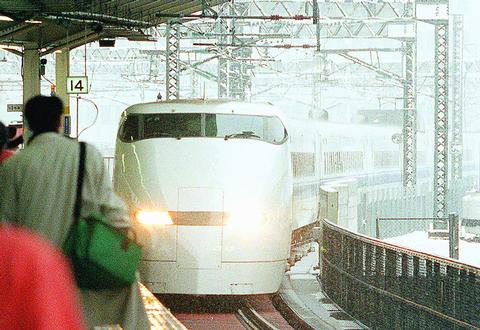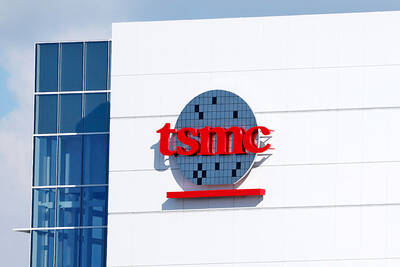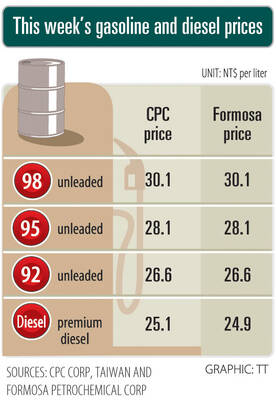Last year's disastrous earthquake may end up costing the Taiwan High Speed Rail project more than NT$50 billion and push the plan six months behind schedule, project officials said yesterday.
The 345km project to link Taipei and the southern city of Kaohsiung was interrupted by the 921 quake, which literally moved mountains in central Taiwan and forced officials to re-survey the entire train route and redesign stations, rails and tunnels.
According to officials at the Taiwan High Speed Rail Corp (

PHOTO: AFP
"If we follow the new codes outright, the [construction] cost will increase by NT$40 billion to NT$50 billion," said Edward Lin, director of operations and management at the rail company.
He said that these figures are based on internal research, and that the company has not yet asked contractors to submit their estimates, which "could place the figure much higher."
To keep the project moving while the government finalizes new building standards, work contracts are still being awarded with a clarified formula for dispute resolution as new construction codes are made law.
In addition, a technician from the corporation said the earthquake has caused "at least six months" delay in work due to design changes and time spent re-surveying the island's terrain.
The rail corporation also sent its engineers down to Puli (
"We were pretty involved in the 921 earthquake clean-up," he said.
The crew also had to re-map Taiwan, putting together new surveys of a region shaken so hard "a lot of surveyed monuments -- control points that have been established in the ground -- have moved."
The company has had to recreate all of the island's terrain data.
Officials from the Ministry of Transportation and Communications' Bureau of Taiwan High Speed Rail (
"They need to do research to determine what kind of impact the temblor had in terms of time and cost," said a bureau official, speaking under condition of anonymity. "Once they have formally prepared this information, it will be submitted to us."

Real estate agent and property developer JSL Construction & Development Co (愛山林) led the average compensation rankings among companies listed on the Taiwan Stock Exchange (TWSE) last year, while contract chipmaker Taiwan Semiconductor Manufacturing Co (TSMC, 台積電) finished 14th. JSL Construction paid its employees total average compensation of NT$4.78 million (US$159,701), down 13.5 percent from a year earlier, but still ahead of the most profitable listed tech giants, including TSMC, TWSE data showed. Last year, the average compensation (which includes salary, overtime, bonuses and allowances) paid by TSMC rose 21.6 percent to reach about NT$3.33 million, lifting its ranking by 10 notches

SEASONAL WEAKNESS: The combined revenue of the top 10 foundries fell 5.4%, but rush orders and China’s subsidies partially offset slowing demand Taiwan Semiconductor Manufacturing Co (TSMC, 台積電) further solidified its dominance in the global wafer foundry business in the first quarter of this year, remaining far ahead of its closest rival, Samsung Electronics Co, TrendForce Corp (集邦科技) said yesterday. TSMC posted US$25.52 billion in sales in the January-to-March period, down 5 percent from the previous quarter, but its market share rose from 67.1 percent the previous quarter to 67.6 percent, TrendForce said in a report. While smartphone-related wafer shipments declined in the first quarter due to seasonal factors, solid demand for artificial intelligence (AI) and high-performance computing (HPC) devices and urgent TV-related orders

Prices of gasoline and diesel products at domestic fuel stations are this week to rise NT$0.2 and NT$0.3 per liter respectively, after international crude oil prices increased last week, CPC Corp, Taiwan (台灣中油) and Formosa Petrochemical Corp (台塑石化) said yesterday. International crude oil prices last week snapped a two-week losing streak as the geopolitical situation between Russia and Ukraine turned increasingly tense, CPC said in a statement. News that some oil production facilities in Alberta, Canada, were shut down due to wildfires and that US-Iran nuclear talks made no progress also helped push oil prices to a significant weekly gain, Formosa said

MINERAL DIPLOMACY: The Chinese commerce ministry said it approved applications for the export of rare earths in a move that could help ease US-China trade tensions Chinese Vice Premier He Lifeng (何立峰) is today to meet a US delegation for talks in the UK, Beijing announced on Saturday amid a fragile truce in the trade dispute between the two powers. He is to visit the UK from yesterday to Friday at the invitation of the British government, the Chinese Ministry of Foreign Affairs said in a statement. He and US representatives are to cochair the first meeting of the US-China economic and trade consultation mechanism, it said. US President Donald Trump on Friday announced that a new round of trade talks with China would start in London beginning today,